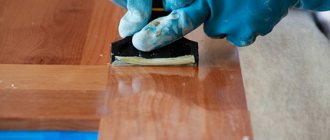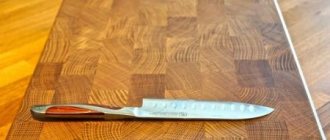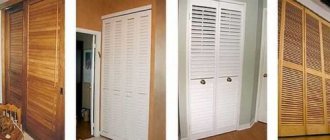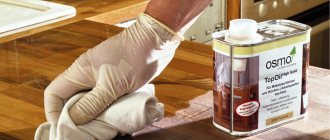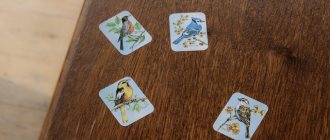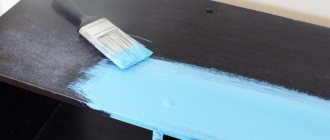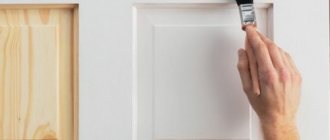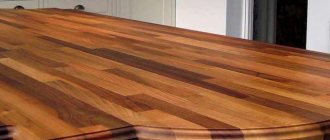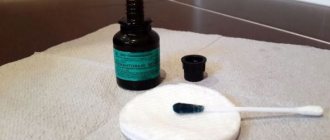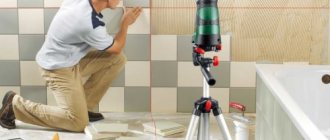Technical features of the event
Almost all types of varnishes form a film. The compositions differ in the principle of action and in the thickness of the coating formed. Therefore, there is no universal way to remove it.
The choice of solution for how to remove varnish from a wooden surface depends on the following criteria:
- density and coating layer;
- chemical composition of the finish;
- the nature of the working foundation.
The last point is especially important. To work with fabrics, glass or parquet, you need to use different techniques. Let's take a closer look at each of them.
Chemicals for removing varnish
- Cleaners and detergents that can be used to remove a thin layer of varnish on a polished wooden surface. You just have to rub it well with a stiff brush to peel off the varnish.
- Organic solvents (white spirit, solvent, etc.) are used for strong adhesion of the varnish to the surface. To clean wood, the solvent is sprayed or sponged onto the varnished surface, left to soak, and then mechanical devices are used, depending on the thickness of the varnish layers. The thinnest layers are removed with simple sandpaper, and several layers have to be removed with a spatula.
- Special chemical removers, gel- or powder-like, in a ready-made solution, can be used for different types of varnish.
How do special washes work?
- Removes the thickest layers of varnish.
- Cleans the pores of untreated wood into which the varnish has been absorbed.
- The highest degree of adhesion will be destroyed if a thick layer of gel-like mass or paste is applied to a wooden surface with a spatula or brush. The action time is indicated in the instructions, but it is better to leave the product for a full chemical reaction for 2-4 hours, observing changes on the surface. To enhance the effect, wooden products are covered with a film (the so-called “compress”).
- The surface cleared of varnish is washed off with water and wiped dry with a rag. After complete drying, the wooden surface is ready for new painting.
Description of various methods
Removing the varnish coating involves direct action on the film. This may be mechanical force, the use of chemically active compounds or thermal pressure. Each option has its own characteristics.
Mechanical impact
The easiest way to remove varnish from wood or other surfaces is to peel off the film by physical force. To do this, use a tool with stiff bristles or a metal blade.
Manual scraper for mechanical removal of paintwork materials Source vseinstrumenti.ru
Thin-layer coatings can also be abraded with varying degrees of grit abrasive. As an alternative to ready-made devices, blades, knives, and glass can be used. The latter, however, wears off very quickly. In any case, you need to protect your hands from cuts.
In addition to hand tools, there are analogs for use with electrical equipment. Thus, an analogue of a cord brush are attachments with metal bristles, which can be installed in a chuck for a drill and screwdriver. With an angle grinder, flap discs with bristles along the edge and emery or grinding wheels are used. The latter are fixed on a special platform called a plate.
Another solution to removing varnish from a wooden surface is a specialized tool. This is a sanding machine. There are three types:
- vibration - a rectangular platform with a small amplitude makes reciprocating movements in the longitudinal direction;
Vibrating grinder Source gidpokraske.ru
- tape - here the sandpaper is represented by a closed narrow strip, which the mechanism rotates in one direction in a straight line relative to the tool;
- eccentric - the mechanism transmits translational and reciprocating circular movements to the platform.
The high efficiency of each of the tools is the main advantage. But during the grinding and polishing process, a large amount of dust is generated. This problem can only be solved with models that can function in conjunction with a vacuum cleaner. Practice shows that a simple dust collector slightly improves the situation.
The listed solutions have both advantages and disadvantages. On the one hand, there is no need to breathe toxic substances, there is no risk of changing the color of the working base, and you can control the entire process. But on the other hand, in addition to the dust generated, there is a risk of mechanical damage to the wood structure, fabric fibers and scratches on a smooth surface.
See also: Catalog of companies that specialize in finishing materials and related work
Chemical removal
A wide range of products are available on the construction market for removing varnish from wooden surfaces.
Special remover for old paint and varnish Source voil.ru
These can be liquid removers, gel-like compositions, solvents and powders. Let's look at the features of each of them:
- Liquid . The product is used provided that the coating consists of a maximum of three layers. This is justified by the fact that such varnish remover contains solvents that evaporate quickly. That is, chemical reagents can affect the coating for an extremely short period of time. Also, due to the consistency, there is a limitation in the form of vertical bases. Here the wash just runs off.
- Gel and paste . Such compositions can have a chemical effect on the base for a long time. Therefore, they are relevant for removing multi-layer coatings, including vertical ones.
- Powder . This option is more often used in the case of large-scale work, which is justified by convenience and long shelf life. Before use, the material must be dissolved in water to obtain a thick paste-like mass.
Removing coating after chemical exposure Source sdelai-lestnicu.ru
Solvent can also be considered one of the means for removing varnish from wooden surfaces. But here it is important to take into account the fact that the composition is capable of chemically acting on the coating only until it has dried. A spray works a little better, which turns into foam at the exit. This mass is not as fluid as liquids. But the action time is inferior to gels and pastes.
Thermal impact
A relatively universal solution for how to clean varnish from a wooden surface can be considered thermal action. By heating the base, the bond between it and the coating weakens. The film first cracks, then softens. Therefore, it can be easily removed with a regular spatula.
Purchased processing products
We need to figure out how severe the initial destruction of the material is and what tools will be easier to do the job.
Powder materials in this regard are considered the most professional solution, although paste is also pleasing with the result. They are the ones who can easily remove up to ten layers of varnish. It will be enough to dilute the composition with water until a paste-like substance is formed. It is simply applied with a brush to the surface where the old varnish was. The work of removing old varnish from old furniture should be done evenly, without repetition.
Ready-made liquids or gels do not require dilution with water. Such compositions are immediately ready for application using a brush. But these products only remove up to three layers.
The most convenient means for old varnish is a spray, but in terms of effectiveness it will lose to its analogues.
After applying any of the products, the surface is covered with a film. Then they leave it like that for a while. The coating material is removed when the color becomes dark and the varnish itself becomes viscous. The old coating is simply removed from the wood with a spatula. The main thing is to remember that varnished surfaces require special care in the future.
How best to remove old varnish (2 videos)
Nail polish removal methods (22 photos)
Operating Instructions
When choosing what and how to remove varnish from wood, you need to familiarize yourself with the rules of the event in advance. This way the process will be completed with the highest quality possible and without harm to human health. Let's consider the instructions and recommendations of specialists regarding each of the techniques.
Cord brush attachment for a screwdriver Source onlinetrade.ru
Mechanical removal technology
The first thing to do is determine the thickness of the coating layer to be removed. This can be all of the varnish or just part of it. The second option is provided by the base preparation technology if subsequent varnishing with a material similar in characteristics is planned.
Next, select a tool. It is easier to remove the top layers with coarse cord brushes and coarse-grain abrasives. To prevent damage to the base, you need to gradually reduce the degree of aggressiveness of the physical impact. The process is completed by sanding the working area with fine-grained sandpaper. After removing dust and dirt, you can begin further finishing work.
Chemical Removal Technology
The process of removing varnish from wood consists of several stages. But before this, it is important to protect surrounding objects, hands, respiratory organs and eyes from chemical exposure.
Working with chemical compounds in rubber gloves Source berkem.ru
What paint should I use on a varnished wooden surface?
Selection of paint and varnish material
- Acrylic paints, polyurethane, perchlorovinyl or oil bases, or opaque enamel.
- Stain, varnish
, oil impregnation. ... - If you want to choose an odorless paint coating for wooden doors, we recommend giving preference to acrylic compositions.
Interesting materials:
How does an aquarium heater work? How does aquastop work on a hose? How does aquastop work in a washing machine? How does Aquastop work? How does the Yandex Zen algorithm work? How does the YouTube algorithm work? How does the YouTube algorithm work? How does Alice Yandex work? How does anaerobic glue work? How does Android TV Box work?
Briefly about the main thing
There are three ways to remove nail polish.
The mechanical option involves the use of brushes, scrapers, abrasives and similar replacement equipment for power tools.
The chemical method involves the use of liquids, gels, pastes and powders to prepare a working mass that softens the varnish coating.
Thermal option - exposure to the surface using a hair dryer and subsequent removal of the coating with a metal spatula.
Each of the methods is accompanied by the formation of dust or the release of toxic substances, so you need to work using protective gloves, goggles and a respirator.
The choice of method is determined by the thickness of the old coating, the nature of the varnish and working base, and the purpose of the event.
Ratings 0
Tools and materials
Before carrying out restoration work, you need to prepare tools and protective equipment:
- Sandpaper;
- Sander;
- Construction hair dryer;
- Putty knife;
- Brush;
- Wire brush;
- Blowtorch;
- Foam sponge;
- Cellophane film;
- Wash;
- Protective glasses;
- Latex gloves;
- Respirator.
Tip: “Professionals recommend using a spatula without sharp edges. On new instruments, the metal plane has sharp corners. You can round them with a file or grinder. Otherwise, the restored coating will be damaged. A plastic tool would be ideal.”
Re-varnishing the floor
New coats of varnish should only be applied to the prepared floor.
- New coats of varnish should only be applied to the prepared floor. Therefore, you will first have to dry the boards well and clean them of dust.
- Before applying varnish with a brush or roller, treat the wood with an antiseptic. In this case, you need to ensure that the wood is well saturated.
- After the antiseptic has completely dried, you can begin to varnish the floor. Decide for yourself how many layers of coating to apply, but always at least 2.
- Since the acrylic product dries from 2 to 4 hours, it is worth pausing between stages of applying varnish. As soon as the previous layer has dried, you can apply a new one.
The consumption of acrylic varnish for wooden floors is generally 100-120 ml/m2. Therefore, it is important to carefully calculate the amount of product needed and buy it at a favorable price. At the same time, we note that the price of acrylic varnish at points of sale starts from $50 per 5 liter canister.
It is worth remembering that on average, varnish consumption during the first application is about 1 liter per 8-10 m2. When applying the product again, its consumption is significantly reduced and is already about 1 liter per 12-15 m2.
Important: Reviews of nail polish removal work from many users are still in favor of chemical removers.
How to remove varnish from parquet
Classic types of parquet floors usually have a varnish protective coating. It makes wood floors look more attractive. Parquet varnish also acts as an additional protection for wood from the influence of physical and mechanical stress during operation. Parquet varnish has a special composition, which determines its stability and service life. Over time, the coating will fade, crack, and wear out. To return the floors to their original appearance, you will need to remove the old varnish from the parquet.
You can remove old varnish from parquet manually or using special equipment
Machine scraping method
Should I hire professional parquet floorers to solve the problem of restoring wooden floors? Not everyone has this opportunity. Often it all comes down to price. Local restoration can be carried out independently; it is enough to purchase the necessary equipment and fresh parquet chemicals.
Large-scale restoration of the varnish coating will require preliminary scraping or sanding. First you need to determine how many cycles the parquet product corresponds to. The more decorative the parquet, the fewer cycles it has. With a lamella thickness of 15 mm, the floor will withstand up to 5 cycles, 8 mm or less - no more than 2-3 times.
Sanding is carried out with a special electric machine that can be bought, which is very cumbersome, because it is rarely used at home. It is better to rent it from a company that provides such parquet repair services.
You can rent a sanding machine
Manual scraping method
There are different ways to remove old varnish by hand. Again, the choice of tool depends on the thickness of the wooden floor profile. The financial side of the issue is as important as taking into account the volume of planned work.
Regular sandpaper with a coarse abrasive will help remove the varnish. The event is a little dusty, but quite productive. Sandpaper allows you to simultaneously remove the old protective layer and level the surface of the floors.
Sandpaper is convenient to use for local reconstruction of varnish: stains, cracks, chips, abrasion. The cleaned surface is treated with acetone, which will remove small particles of scraped varnish. After which BF-6 glue is applied. The last stage is repeated wiping with solvent.
BF-6 glue is an alcohol solution of phenol-formaldehyde resin with polyvinyl butyral, softeners and plasticizers. Not subject to rotting and corrosion, resistant to the influence of the atmosphere, oils, gasoline, kerosene, mold, water and acids, less resistant to alkalis, alcohols, and solvents.
Hand scrapers are sold in almost every hardware store. The tool is available in a variety of scraper widths and handle lengths. Note that the work of hand scrapers with a short handle is more tedious, but cleaning the parquet from old varnish will be better.
You can also remove the varnish with a hand tool and sandpaper.
This process is labor-intensive. The work requires accuracy and attention, since when removing varnish, the top layer of wood is cut off along the wood fibers. Be sure to pay attention to the nature of the cut in the manufactured profile:
- radial (annual rings are located perpendicular to the surface of the bar);
- tangential (the plane of the cut runs tangent to the annual layer of the trunk);
- mixed.
Do-it-yourself cleaning of wooden floors from old varnish is only half of the restoration work. Afterwards you will need to apply a primer (this will ensure better adhesion of the varnish layer) and sand the surface of the wood. At the end, the floors are re-varnished.
Unusual scraping tools
You can completely clean parquet floors of old varnish with your own hands, or rather, with your own feet. To do this, find a pair of flat-soled shoes among your shoes and glue sandpaper to the bottom. The first “pass” must be made with abrasive No. 40 (primary grinding), the second - with abrasive No. 80 (finishing).
Shuffling your feet is much easier than manually operating on your knees. And the procedure itself will be more accurate.
Some folk craftsmen, among other tools, can find a sample of a handmade scraper, made with their own hands from improvised materials. Actually, other tools are used, specially tailored to the task. For example, an iron rod of a plane with a hooked tip.
The sharp end must be given the required shape:
- the metal is heated to red;
- cools slightly in natural conditions;
- clamped in a vice with a pipe;
- the end is bent along the pipe with light, even blows of the hammer;
- the angle is adjusted;
- heats up;
- The outer side of the bend is sharpened.
Manual scraping of parquet will be easier if you use scrapers adapted for this task. The tool is prepared in the same way as a converted plane tip.
A scraper is a hand-held non-mechanical cleaning tool used by ship repairers and shipbuilders. They can remove scale, loosen and remove rust, clean off old paint, and remove various contaminants, including deep ones.
Instead of an afterword
Any attempts to manually remove varnish from a parquet floor require maximum effort, care and accuracy. The difficulty lies in the fact that you need to constantly control the cutting force of the parquet and monitor the sharpness of the tool. Dust and dirt cannot be avoided. Therefore, it does not hurt to use personal protective equipment: a respiratory mask, gloves, goggles. At the same time, restoring wooden floor coverings yourself is quite possible and much cheaper than the services of parquet specialists.
Source: https://kraska.guru/laki/rabota-s-lakami/snyat-s-parketa.html
Mechanical nail polish removal
You can also remove acrylic varnish from the floor mechanically.
- You can also remove acrylic varnish from the floor by primitive scraping. To do this, you can use either a grinding machine or a professional unit. In the first case, you can do the work yourself, but be sure to use safety glasses, a respirator and headphones. The grinder should be moved along the floor from the walls to the center of the room and closer to the exit. We subsequently remove all wood-varnish dust with a vacuum cleaner.
- In the second case, it is better to invite specialists. Because handling a heavy scraping machine requires skill. The price of floor treatment will depend on the square footage, but on average it ranges from $5/m2.
If you decide to handle the scraping machine yourself, then consider some features:
- When turning on the unit, it is better to raise it, since the grinding elements can go deeper into the floor boards and unsightly deform it;
- When turning the machine indoors, it is also recommended to slightly lift the unit towards you;
- It is better to move around the perimeter first diagonally and only so that the grinding unit slightly overlaps the already processed strip. Afterwards, it is worth changing the direction of the unit in the diagonally opposite direction.
- Removing nail polish in this way can be done both in large and small rooms.
Important: after treating the floor with a scraping machine, it is necessary to remove any remaining dust (no matter how much there is) and, if necessary, repair damaged floor elements. You need to cover the wood with new layers of paint using a brush or roller, moving along the grain of the wood.

